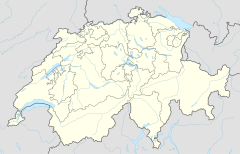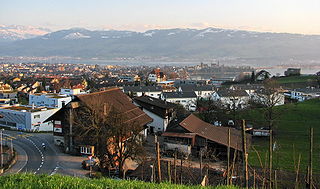
Rapperswil-Jona is a municipality in the Wahlkreis (constituency) of See-Gaster in the canton of St. Gallen in Switzerland. Besides Rapperswil and Jona, which were separate municipalities until 2006, the municipality includes Bollingen, Busskirch, Curtiberg, Kempraten-Lenggis, Wagen, and Wurmsbach.
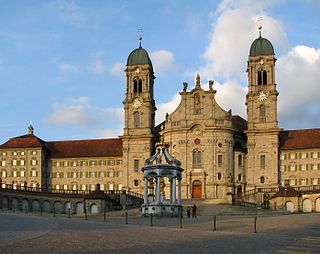
Einsiedeln Abbey is a Benedictine monastery in the village of Einsiedeln in the canton of Schwyz, Switzerland. The abbey is dedicated to Our Lady of the Hermits, the title being derived from the circumstances of its foundation, for the first inhabitant of the region was Saint Meinrad, a hermit. It is a territorial abbey and, therefore, not part of a diocese, subject to a bishop. It has been a major resting point on the Way of St. James for centuries.

Ufenau is an island located, with the neighbouring island of Lützelau, in Lake Zürich in Switzerland between Freienbach and Rapperswil. Highlights on Ufenau include St. Peter & Paul church, St. Martin's chapel, and Ufenau's idyllic landscape in the Frauenwinkel protected area.

Rapperswil is a former municipality and since January 2007 part of the municipality of Rapperswil-Jona in the Wahlkreis (constituency) of See-Gaster in the canton of St. Gallen in Switzerland, located at the east side of the Lake Zurich.

Seedamm is the partially artificial causeway and bridge at the most narrow area of Lake Zurich, between Hurden (SZ) and Rapperswil (SG). The Seedamm carries a road and a railway across the lake, with the railway being used by the S5 and S40 lines of the S-Bahn Zürich and by the Südostbahn Voralpen Express.

Rapperswil Castle is a castle, built in the early 13th century AD by the House of Rapperswil in the former independent city of Rapperswil.
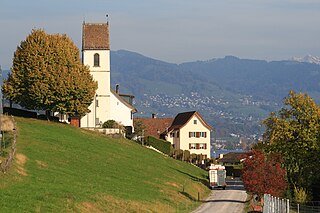
Bollingen is a village (Kirchdorf) within the Swiss municipality of Rapperswil-Jona in the canton of St. Gallen.

Heilig Hüsli is a bridge chapel in Rapperswil, Canton of St. Gallen, Switzerland.
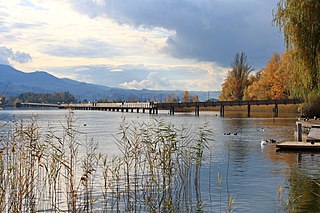
Holzbrücke Rapperswil-Hurden is a wooden pedestrian bridge between the city of Rapperswil and the village of Hurden crossing the upper Lake Zürich (Obersee) in Switzerland. The prehistoric timber piles discovered to the west of the Seedamm date back to 1523 BC. The island settlement Technikum is a prehistoric pile-dwelling settlement which is part of the UNESCO World Heritage Site Prehistoric Pile dwellings around the Alps. The first wooden footbridge led across Lake Zürich, followed by several reconstructions at least until the late 2nd century AD when the Roman Empire built a 6 metres (20 ft) wide wooden bridge. Between 1358 and 1360, Rudolf IV, Duke of Austria, built a 'new' wooden bridge across the lake that was used until 1878. On 6 April 2001, the reconstructed wooden footbridge was opened, being the longest wooden bridge in Switzerland.

Münsterhof is a town square situated in the Lindenhof quarter in the historical center of Zürich, Switzerland. Münsterhof is the largest town square within the Altstadt of Zürich, and is surrounded by medieval buildings. The area forms part of the southern extension of the Quaianlagen promenades of Zürich's lakefront.
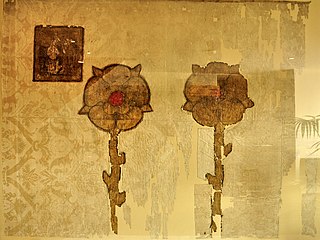
The House of Rapperswil respectively Counts of Rapperswil ruled the upper Zürichsee and Seedamm region around Rapperswil and parts of, as of today, Swiss cantons of St. Gallen, Glarus, Zürich and Graubünden when their influence was most extensive around the 1200s until the 1290s. They acted also as Vogt of the most influential Einsiedeln Abbey in the 12th and 13th century, and at least three abbots of Einsiedeln were members of Rapperswil family.

Elisabeth von Rapperswil was the last countess of the House of Rapperswil, and secured by her second marriage the female line of the Counts of Rapperswil and the extensive possessions of Rapperswil in the former Zürichgau to the Laufenburg line. Her son by first marriage was Reichsvogt Wernher von Homberg, and her oldest son by second marriage was Count Johann von Habsburg-Laufenburg who passed over the title of the count of Rapperswil to his oldest son Johann II and his brothers Rudolf and Gotfried.

The Obersee is the smaller of the two parts of Zürichsee in the cantons of St. Gallen and Schwyz in Switzerland.

The Grynau Castle is the name of a castle tower in the municipality of Tuggen in the canton of Schwyz, built by the House of Rapperswil in the early 13th century AD.

Buechberg is an elongated molasse hill in the Swiss cantons of Schwyz and St. Gallen on Obersee lakeshore.

Johann I von Habsburg-Laufenburg was the Count of Habsburg-Laufenburg and later Count of the House of Rapperswil.

Johann II von Habsburg-Laufenburg was the Count of Habsburg-Laufenburg and later Count of the House of Rapperswil.
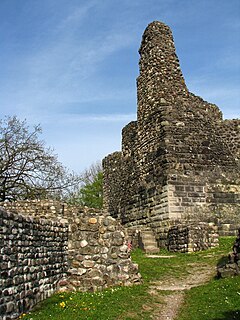
Alt-Regensberg Castle is a hill castle which was built about the mid-11th century AD by the House of Regensberg in the Swiss municipality of Regensdorf in the Canton of Zürich.

Reformierte Kirche Rüti is an Evangelical Reformed church in the Swiss municipality of Rüti in the Canton of Zürich. It was built between 1214 and 1219 AD as the Romanesque style church of the then Premonstratensian Kloster Rüti, an abbey that was founded in 1206 by the House of Regensberg and suppressed in 1525 as part of the Reformation in Zürich.
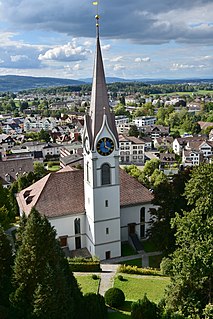
Reformierte Kirche Uster is an Evangelical Reformed church in the Swiss municipality of Uster in the Canton of Zürich that was built in 1824. The predecessor St. Andreas church, situated next to the Uster Castle, was given by the House of Rapperswil and first mentioned in 1099 AD.

